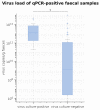Comparison of Eight Commercially Available Faecal Point-of-Care Tests for Detection of Canine Parvovirus Antigen
- PMID: 34696513
- PMCID: PMC8540396
- DOI: 10.3390/v13102080
Comparison of Eight Commercially Available Faecal Point-of-Care Tests for Detection of Canine Parvovirus Antigen
Abstract
A real-time polymerase chain reaction (qPCR) is considered the gold standard for the laboratory diagnosis of canine parvovirus (CPV) infection but can only be performed in specialized laboratories. Several point-of-care tests (POCT), detecting CPV antigens in faeces within minutes, are commercially available. The aim of this study was to evaluate eight POCT in comparison with qPCR. Faecal samples of 150 dogs from three groups (H: 50 client-owned, healthy dogs, not vaccinated within the last four weeks; S: 50 shelter dogs, healthy, not vaccinated within the last four weeks; p = 50 dogs with clinical signs of CPV infection) were tested with eight POCT and qPCR. Practicability, sensitivity, specificity, positive (PPV) and negative predictive values (NPV), as well as overall accuracy were determined. To assess the differences between and agreement among POCT, McNemar's test and Cohen's Kappa statistic were performed. Specificity and PPV were 100.0% in all POCT. Sensitivity varied from 22.9-34.3% overall and from 32.7-49.0% in group P. VetexpertRapidTestCPVAg® had the highest sensitivity (34.3% overall, 49.0% group P) and differed significantly from the 3 POCT with the lowest sensitivities (Fassisi®Parvo (27.7% overall, 36.7% group P), Primagnost®ParvoH+K (24.3% overall, 34.7% group P), FASTest®PARVOCard (22.9% overall, 32.7% group P)). The agreement among all POCT was at least substantial (kappa >0.80). A positive POCT result confirmed the infection with CPV in unvaccinated dogs, whereas a negative POCT result did not definitely exclude CPV infection due to the low sensitivity of all POCT.
Keywords: CPV; POCT; diagnosis; in-house test; parvovirosis; sensitivity; specificity.
Conflict of interest statement
The authors declare no potential conflict of interest with respect to the research, authorship, and/or publication of this article. Although the POCT were provided for free by IDEXX, Fassisi, Dechra, Megacor, Bionote, Vetexpert and Zoetis, the funders had no role in the design of the study; in the collection, analyses, or interpretation of data; in the writing of the manuscript; or in the decision to publish the results. There is no commercial conflict of interest as the information generated here is solely for scientific dissemination. The authors declare that they have no competing interests.
Figures


Similar articles
-
Comparison of Four Commercially Available Point-of-Care Tests to Detect Antibodies against Canine Parvovirus in Dogs.Viruses. 2020 Dec 23;13(1):18. doi: 10.3390/v13010018. Viruses. 2020. PMID: 33374843 Free PMC article.
-
Diagnostic Challenges in Canine Parvovirus 2c in Vaccine Failure Cases.Viruses. 2020 Sep 3;12(9):980. doi: 10.3390/v12090980. Viruses. 2020. PMID: 32899378 Free PMC article.
-
Influence of clinical and laboratory variables on faecal antigen ELISA results in dogs with canine parvovirus infection.Vet J. 2015 Jun;204(3):304-8. doi: 10.1016/j.tvjl.2015.03.009. Epub 2015 Mar 16. Vet J. 2015. PMID: 25920770
-
[Prevention of canine parvovirosis - Part 1: Humoral and cellular immunity].Tierarztl Prax Ausg K Kleintiere Heimtiere. 2021 Feb;49(1):44-50. doi: 10.1055/a-1319-4564. Epub 2021 Feb 15. Tierarztl Prax Ausg K Kleintiere Heimtiere. 2021. PMID: 33588464 Review. German.
-
Canine parvovirus--a review of epidemiological and diagnostic aspects, with emphasis on type 2c.Vet Microbiol. 2012 Feb 24;155(1):1-12. doi: 10.1016/j.vetmic.2011.09.007. Epub 2011 Sep 12. Vet Microbiol. 2012. PMID: 21962408 Free PMC article. Review.
Cited by
-
Canine Parvovirus 2C Identified in Dog Feces from Poop Bags Collected from Outdoor Waste Bins in Arizona USA, June 2022.Transbound Emerg Dis. 2023;2023:5596886. doi: 10.1155/2023/5596886. Epub 2023 Oct 4. Transbound Emerg Dis. 2023. PMID: 38983716 Free PMC article.
-
Point-of-care testing in companion and food animal disease diagnostics.Front Vet Sci. 2022 Nov 25;9:1056440. doi: 10.3389/fvets.2022.1056440. eCollection 2022. Front Vet Sci. 2022. PMID: 36504865 Free PMC article. Review.
-
Molecular detection and quantification of canine parvovirus 2 using a fast and sensitive SYBR® green-based quantitative polymerase chain reaction assay in dogs affected with gastroenteritis.Vet World. 2024 Oct;17(10):2286-2294. doi: 10.14202/vetworld.2024.2286-2294. Epub 2024 Oct 17. Vet World. 2024. PMID: 39619927 Free PMC article.
-
Involvement of canine parvovirus in mRNA expression levels of key lectins and caspases in blood leukocytes.Vet Res Commun. 2024 Nov 19;49(1):12. doi: 10.1007/s11259-024-10586-8. Vet Res Commun. 2024. PMID: 39560803
-
Sensitivity of lateral flow technique for diagnosis of canine parvovirus.Sci Rep. 2024 Mar 1;14(1):5060. doi: 10.1038/s41598-024-55548-x. Sci Rep. 2024. PMID: 38424259 Free PMC article.
References
Publication types
MeSH terms
Substances
LinkOut - more resources
Full Text Sources

